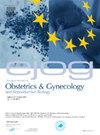去甲肾上腺素与苯肾上腺素治疗先兆子痫患者椎管后低血压的有效性和安全性:系统回顾和荟萃分析。
IF 2.1
4区 医学
Q2 OBSTETRICS & GYNECOLOGY
European journal of obstetrics, gynecology, and reproductive biology
Pub Date : 2024-10-16
DOI:10.1016/j.ejogrb.2024.10.012
引用次数: 0
摘要
目的我们进行了一项系统性综述和荟萃分析,以评估对接受剖宫产术的先兆子痫产妇施用去甲肾上腺素或苯肾上腺素治疗脊柱术后低血压后的母胎结局:我们在PubMed、Embase、Scopus、Cochrane CENTRAL和clinicaltrials.gov上进行了检索,检索时间从开始到2024年6月:研究选择:纳入了对接受去甲肾上腺素或苯肾上腺素治疗脊柱术后低血压的先兆子痫妇女的随机对照试验:两名审稿人将数据提取到 Excel 电子表格中。使用 R 4.4 版本进行统计分析。使用随机效应模型计算风险比(RR)及其 95% 置信区间(CI)并进行汇总。质量评估采用 Cochrane 的偏倚风险(RoB 2)工具。本综述已在 PROSPERO 注册(CRD42024532740):本综述共纳入了 4 项试验,共有 413 名参与者。206名患者接受了去甲肾上腺素治疗,207名患者接受了苯肾上腺素治疗。与苯肾上腺素组相比,去甲肾上腺素组产妇心动过缓的发生率明显降低(RR = 0.25,95 % CI = 0.16 至 0.39,p 结论:去甲肾上腺素组产妇心动过缓的发生率明显低于苯肾上腺素组(RR = 0.25,95 % CI = 0.16 至 0.39,p 结论):对接受剖宫产手术的先兆子痫患者治疗椎管内术后低血压时,发现注射剂量的去甲肾上腺素和去甲肾上腺素对新生儿的影响相当。然而,与 PE 相比,NE 的心动过缓发生率更低,因此对产妇的安全性更高。本文章由计算机程序翻译,如有差异,请以英文原文为准。
Efficacy and safety of norepinephrine versus phenylephrine for post-spinal hypotension in preeclamptic patients: A systematic review and meta-analysis
Objective
We conducted a systematic review and meta-analysis to evaluate the fetomaternal outcomes after the administration of norepinephrine or phenylephrine for the treatment of post spinal hypotension in preeclamptic women undergoing a cesarean section.
Data sources
We searched on PubMed, Embase, Scopus, Cochrane CENTRAL, and clinicaltrials.gov from inception till June 2024.
Study selection
Randomized controlled trials of preeclamptic women receiving norepinephrine or phenylephrine for post spinal hypotension were included.
Data extraction and synthesis
Two reviewers extracted data onto an Excel spreadsheet. R version 4.4 was used for statistical analysis. Risk ratios (RR) and their 95% confidence intervals (CIs) were calculated and pooled using the random effects model. Cochrane’s risk of bias (RoB 2) tool was used for quality assessment. This review has been registered with PROSPERO (CRD42024532740).
Results
A total of 4 trials, comprising 413 participants, were included in this review. 206 patients received norepinephrine, while 207 received phenylephrine. The incidence of maternal bradycardia was significantly lower in the norepinephrine group compared with the phenylephrine group (RR = 0.25, 95 % CI = 0.16 to 0.39, p < 0.01). There were no statistical differences in other maternal outcomes or in the umbilical artery and umbilical vein blood gas analysis values. We also analyzed adverse events such as nausea (RR = 1.00, 95 % CI: 0.62 to 1.60, p = 1.00) and vomiting (RR = 0.99, 95 % CI: 0.89 to 1.11, p = 0.61), but they did not show a significant association with any group. All the trials had a moderate or low risk of bias.
Conclusion
Bolus doses of NE and PE for the treatment of post-spinal hypotension in preeclamptic women undergoing cesarean sections were found to exhibit comparable neonatal outcomes. However, NE provided superior maternal safety due to a lower incidence of bradycardia compared to PE.
求助全文
通过发布文献求助,成功后即可免费获取论文全文。
去求助
来源期刊
CiteScore
4.60
自引率
3.80%
发文量
898
审稿时长
8.3 weeks
期刊介绍:
The European Journal of Obstetrics & Gynecology and Reproductive Biology is the leading general clinical journal covering the continent. It publishes peer reviewed original research articles, as well as a wide range of news, book reviews, biographical, historical and educational articles and a lively correspondence section. Fields covered include obstetrics, prenatal diagnosis, maternal-fetal medicine, perinatology, general gynecology, gynecologic oncology, uro-gynecology, reproductive medicine, infertility, reproductive endocrinology, sexual medicine and reproductive ethics. The European Journal of Obstetrics & Gynecology and Reproductive Biology provides a forum for scientific and clinical professional communication in obstetrics and gynecology throughout Europe and the world.

 求助内容:
求助内容: 应助结果提醒方式:
应助结果提醒方式:


